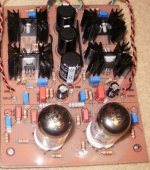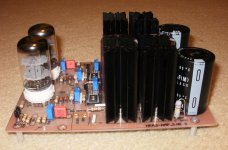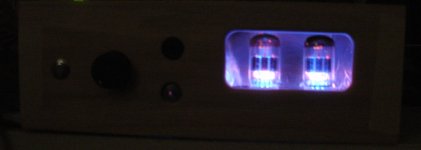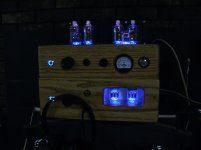How does the sound quality compare between all-tube and tube/mosfet hybrid amplifiers (of a similar output power) ?
I'm interested in building a HiFi tube (or hybrid) amp, after being very impressed by a friend's EL34 based PP amp. A hybrid would potentially be more compact, but would it sacrifice sound quality ?
I'm interested in building a HiFi tube (or hybrid) amp, after being very impressed by a friend's EL34 based PP amp. A hybrid would potentially be more compact, but would it sacrifice sound quality ?
How does the sound quality compare between all-tube and tube/mosfet hybrid amplifiers (of a similar output power) ?
That depends on the quality of each amp and the listener. Audio and music is a very subjective thing. Also, it's possible to make good or bad versions of either topology.
i prefer all tubes in my signal path. Most hybrids use SS output sections, but IMO the output tubes and transformer are what give tube amps most of their distinctive qualities. SS guys call it "euphonic distortion", but I don't buy that explanation since I have built and listened to tube amps that measure as good as a decent solid state amp, but they still sound like a tube amp. Since you're buddy's amp was presumably all tube and you liked it, you should probably build an all tube amp.I'm interested in building a HiFi tube (or hybrid) amp, after being very impressed by a friend's EL34 based PP amp. A hybrid would potentially be more compact, but would it sacrifice sound quality ?
Also, FWIW even though mosfets are the "in" thing these days, I still prefer good bipolar transistors over mosfets in SS amps. But I will still take tooooobs over SS any day
Last edited:
Going hybrid would be no problem in terms of SQ. Going hybrid and doing a poor job would. Just as a poor quality tuber will sound like a potato (bad). Defiant has the goat in the pen on this one. Unless everything in your music library was mastered with all tubes, a grain of sand here and there won't hurt at all.
Just cross your fingers, and try not to think of all those op amps that silicon-free sound went through on the mixing board!
Just cross your fingers, and try not to think of all those op amps that silicon-free sound went through on the mixing board!
All tube mixing boards are still being made! Also some recordists are opting for purist techniques using only two mics and a tube pre-amps. Also, I see more use of Ampex and Studer tube recorders. Now when we get to CD recording and reproduction, we are opening another can of silicon entirely.Regards
Another point of view, I prefer triode connected output tubes over UL and over hybrid and over SS. My madness is quite simple. The impedance of speakers varies over frequency so the coupled power output of a SS amp having very low impedance really does not care. It is designed to go to a specific output voltage level and the resultant power is V^2/R. So as the impedance of the speakers goes up, output power goes down. Hybrid outputs are basically the same as SS in this regard, leaving UL and triode connected tubes. UL connected tubes have localized feedback from the UL tap in the transformer that help to control the gain and linearity of the output section desensitizing the tube to output impedance changes. Triode connected tubes are on their own. The speaker impedance is reflected back to the plate so as the speakers impedance increases, so does the gain of the triode, acting as self compensation in correcting, increasing output voltage as speaker impedance increases. I believe it has a lot to do with the individuals' speakers, I can tell a difference in mine. In a lot of tube amps, the choice is a simple flip of a switch to chose output mode, I prefer to hardwire triode mode.......
How does the sound quality compare between all-tube and tube/mosfet hybrid amplifiers (of a similar output power) ?
I'm interested in building a HiFi tube (or hybrid) amp, after being very impressed by a friend's EL34 based PP amp. A hybrid would potentially be more compact, but would it sacrifice sound quality ?
These amps are really common for bass guitars. Maybe the most common type. They will use a tube preamp and SS power section. Typical power is 200 to 1,000 watts You just can't get there with tubes for a sane price, size and weight.
For home HIFi use I'm sure it would work but mostly you will have a mosfet amp. The one little tube in the input secton will not next to nothing to the sound. All that "tube sound" in a HiFi amp is in the power section and that includes the output transformer ( Again, we are talking HiFi here - very different answer if the subject is live music)
I think if you'd build a mosfet power section you get mosfet sound. Has to do with how you'd handle feedback in the amp, I think. It could work, and work well but it will not have a tube sound.
The bass player can use a tube preamp and SS power because he uses the preamp to introduce intentional distortion (maybe 10 to 20% THD) This adds some overtones very much like a wooden sound board does on an acoustic instrument. But this use case is absolutely contrary to what you want. Your preamp tube would be running at very low gain and low distortion. I think hybrids are worth the effort only for live sound, not HiFi.
Last edited:
Guys,
The Devil is very much in the details. One amp in my collection is an older AVA FET-Valve hybrid that sounds damned good. You really can't talk amps, without mentioning the speakers they are mated with. A big part of getting good performance is amp to speaker matching. For instance, the AVA is not good with horns, as things are badly overdamped. OTOH, paired with AR3s or AR9s is "hog heaven".
The Devil is very much in the details. One amp in my collection is an older AVA FET-Valve hybrid that sounds damned good. You really can't talk amps, without mentioning the speakers they are mated with. A big part of getting good performance is amp to speaker matching. For instance, the AVA is not good with horns, as things are badly overdamped. OTOH, paired with AR3s or AR9s is "hog heaven".
Just cross your fingers, and try not to think of all those op amps that silicon-free sound went through on the mixing board!
Fortunately, as long as the op-amps are kept well away from saturation and have good bandwidth, they won't damage the sound too bad. Unless the mixing board is a low quality POS the result depends a lot more on the skill of the recording engineer than the active devices used in the mixing board.
I don't do the thing of putting together a super high-end system to listen to "audiophile" recordings of crap I don't like. I build gear to listen to stuff I do like, and most of it isn't the best when it comes to the engineering and skill in mastering. IME, tubes do a much better job of making such recordings listenable and enjoyable. Many SS amps make you want to stick icepicks in your ears after listening to these same recordings for an hour. By the same token, a good tube amp will do an absolutely stunning job of rendering a good recording, provided you have good matched speakers of course (goes for any system regardless of technology).
Costwise, a decent tube amp will always cost more than a decent SS amp, but truly high end gear is comparable in cost either way. Cheaper SS gear is built with regular parts purchased in tape and reel form and stuffed by automated machines. The circuits are designed to be to be tolerant of wide variations in the active devices so that no culling or matching of parts are needed. High end SS isn't this way - go read some of Nelson Pass's posts where he talks about culling and hand matching transistors. You may have to go through dozens of devices just to get a good matched pair, let alone the larger quantities used in output stages. SS amps also typically use more discrete components, which drives the cost up further. The point is, if you want to build a decent amp a hybrid may be cheaper, but building a GOOD hybrid (or purely SS) amp isn't going to be.
Last edited:
I've noticed that some commercial hybrid amps (such as those from Croft Acoustics), use the output mosfets completely open-loop. But in simulations at least, I've found that the mosfet distortion massively exceeds the triode distortion once you get beyond the 3rd harmonic, producing a raft of higher order products which are absent from the tube.
I guess this means that the mosfet stage would have to be linearised with feedback, but then it might just sound like any other SS amp, as mentioned in the posts above.
Maybe there isn't any substitute for power tubes and transformers, in order to achieve the tube magic.
I guess this means that the mosfet stage would have to be linearised with feedback, but then it might just sound like any other SS amp, as mentioned in the posts above.
Maybe there isn't any substitute for power tubes and transformers, in order to achieve the tube magic.
I'm interested in building a HiFi tube (or hybrid) amp------------
instruments hybrid headamps use a tube preamp combined with SS poweramp, yes
but it is basicly two different amps in one box
more like what you would call an integrated amp in hifi terms
it is not what we understand by a hybrid AMP
many years ago someone got the thought that a small signal tube would be the perfect driver fore mosfets
and the hybrid amp was born
but in reality it might be more like trying to combine the worst of the two
I think the world have moved on since then
but it does seem to become popular again
but mostly fore small classA SS amp
and it may actually make more sense then
these days the 'opposite' hybrid using fet input/driver stage with tube output seems to have been popular in Japan
I suppose first simple steps are learning about impedance matching
Exactly what I mean. There's nothing wrong with solid-state amplification.Fortunately, as long as the op-amps are kept well away from saturation and have good bandwidth, they won't damage the sound too bad.
As with most things in life, there is a time and place for everything. I wanted an all tube headphone amp, but discovered that the various impedances did not sit well with tube designs, White follower, SRPP, SE even a small PP. I compromised and built a couple of different Hybrid amps. The first was a tube-Mosfet opamp design, the second a little more conventional and was preferred.
Attachments
Putting some damper diodes in the source circuit of some Mosfets, with Schade "plate" to "grid" feedback, will give you some output capable devices with triode like curves. Efficiency and cost will end up about the same as tubes though, and it will likely still require an OT.
Then there is another scheme where damper diodes are put in the base circuit of bipolars and Schade feedbacks used, which would also give triode like characteristics and could dispense with the OT.
Then there is another scheme where damper diodes are put in the base circuit of bipolars and Schade feedbacks used, which would also give triode like characteristics and could dispense with the OT.
It's long but worth reading.
http://www.diyaudio.com/forums/tubes-valves/102613-moskido-hybrid-aikido-mosfet-amplifier.html
http://www.diyaudio.com/forums/tubes-valves/102613-moskido-hybrid-aikido-mosfet-amplifier.html
I've been looking at the Semisouth devices, which are reported as being the best sounding current output JFETs. I don't know enough about ss to design anything, but it should be fairly simple to build a SE class A output stage with an OPT, like the Edcor ones with 150 ohms primary and 8 ohms secondary.
One thing is for sure - no electrolytics in the signal path. Yuk. I don't fancy the tube stage used in the Moskido, so I didn't find that thread much use.
What I'd want to drive this with is a voltage stage made from DHTs like 26, with transformer output that would interface with the JFET output stage. That would be the nearest to a good sounding hybrid I can imagine.
I'm getting very fed up with DHT output stages - the tubes are expensive, wear out and have to be replaced, and they consume electricity which is getting increasingly expensive.
Andy
One thing is for sure - no electrolytics in the signal path. Yuk. I don't fancy the tube stage used in the Moskido, so I didn't find that thread much use.
What I'd want to drive this with is a voltage stage made from DHTs like 26, with transformer output that would interface with the JFET output stage. That would be the nearest to a good sounding hybrid I can imagine.
I'm getting very fed up with DHT output stages - the tubes are expensive, wear out and have to be replaced, and they consume electricity which is getting increasingly expensive.
Andy
Last edited:
Hybrid headphone amp chassis completed with the compactron amp sitting on top..... The headphone has RCA jacks in the back daisy chained to the power amp. Each has an over-riding jack in the front for MP3 player input. The headphone amp was a learning project, Plan "A" worked but not as good as hoped, plan "B" was a winner. If you jack up the quiescent current in the output, it can drive 8 ohm speakers.....
Attachments
If you want a true valve amp sound then it needs to be 100% valves.
I have designed and built hybrids and they sound too clean compared to pure a valve amp.
I'm guessing you are referring to a guitar amp? There's no such thing as "too clean" in hi-fi, but there is "harsh".
I'm guessing you are referring to a guitar amp? There's no such thing as "too clean" in hi-fi, but there is "harsh".
The hybrid with a valve front end lacks the warmth of a 100% valve amplifier.
A good guitar valve amp can be clean or have loads of harmonics depending on the sound you want.
- Status
- This old topic is closed. If you want to reopen this topic, contact a moderator using the "Report Post" button.
- Home
- Amplifiers
- Tubes / Valves
- All-tube vs tube/mosfet hybrid ?



